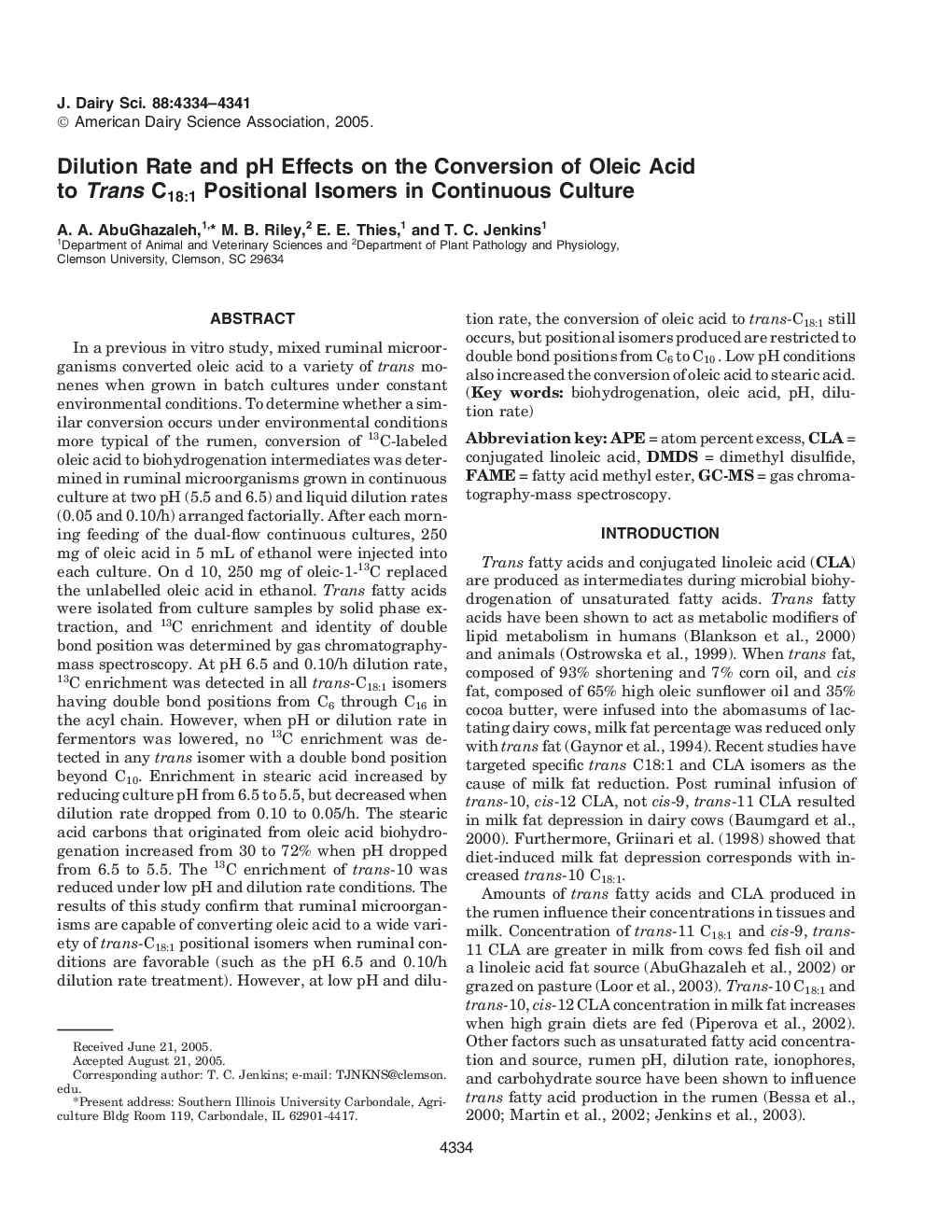| کد مقاله | کد نشریه | سال انتشار | مقاله انگلیسی | نسخه تمام متن |
|---|---|---|---|---|
| 2441676 | 1108150 | 2005 | 8 صفحه PDF | دانلود رایگان |
عنوان انگلیسی مقاله ISI
Dilution Rate and pH Effects on the Conversion of Oleic Acid to Trans C18:1 Positional Isomers in Continuous Culture
دانلود مقاله + سفارش ترجمه
دانلود مقاله ISI انگلیسی
رایگان برای ایرانیان
کلمات کلیدی
APECLADMDSGC-MS - کروماتوگرافی گازی-طیف سنج جرمیOleic acid - اسید اولئیکconjugated linoleic acid - اسید لینولئیک کونژوگهAtom percent excess - بیش از حد اتمbiohydrogenation - بیو هیدروژنdimethyl disulfide - دی متیل دی سولفیدgas chromatography-mass spectroscopy - طیف سنجی جرم کروماتوگرافی گازFatty acid methyl ester - متیل استر اسید چربFAME یا fatty acid methyl esters - متیل استرهای اسید چربDilution rate - میزان انحلال
موضوعات مرتبط
علوم زیستی و بیوفناوری
علوم کشاورزی و بیولوژیک
علوم دامی و جانورشناسی
پیش نمایش صفحه اول مقاله

چکیده انگلیسی
In a previous in vitro study, mixed ruminal microorganisms converted oleic acid to a variety of trans monenes when grown in batch cultures under constant environmental conditions. To determine whether a similar conversion occurs under environmental conditions more typical of the rumen, conversion of 13C-labeled oleic acid to biohydrogenation intermediates was determined in ruminal microorganisms grown in continuous culture at two pH (5.5 and 6.5) and liquid dilution rates (0.05 and 0.10/h) arranged factorially. After each morning feeding of the dual-flow continuous cultures, 250Â mg of oleic acid in 5Â mL of ethanol were injected into each culture. On d 10, 250Â mg of oleic-1-13C replaced the unlabelled oleic acid in ethanol. Trans fatty acids were isolated from culture samples by solid phase extraction, and 13C enrichment and identity of double bond position was determined by gas chromatography-mass spectroscopy. At pH 6.5 and 0.10/h dilution rate, 13C enrichment was detected in all trans-C18:1 isomers having double bond positions from C6 through C16 in the acyl chain. However, when pH or dilution rate in fermentors was lowered, no 13C enrichment was detected in any trans isomer with a double bond position beyond C10. Enrichment in stearic acid increased by reducing culture pH from 6.5 to 5.5, but decreased when dilution rate dropped from 0.10 to 0.05/h. The stearic acid carbons that originated from oleic acid biohydrogenation increased from 30 to 72% when pH dropped from 6.5 to 5.5. The 13C enrichment of trans-10 was reduced under low pH and dilution rate conditions. The results of this study confirm that ruminal microorganisms are capable of converting oleic acid to a wide variety of trans-C18:1 positional isomers when ruminal conditions are favorable (such as the pH 6.5 and 0.10/h dilution rate treatment). However, at low pH and dilution rate, the conversion of oleic acid to trans-C18:1 still occurs, but positional isomers produced are restricted to double bond positions from C6 to C10. Low pH conditions also increased the conversion of oleic acid to stearic acid.
ناشر
Database: Elsevier - ScienceDirect (ساینس دایرکت)
Journal: Journal of Dairy Science - Volume 88, Issue 12, December 2005, Pages 4334-4341
Journal: Journal of Dairy Science - Volume 88, Issue 12, December 2005, Pages 4334-4341
نویسندگان
A.A. AbuGhazaleh, M.B. Riley, E.E. Thies, T.C. Jenkins,